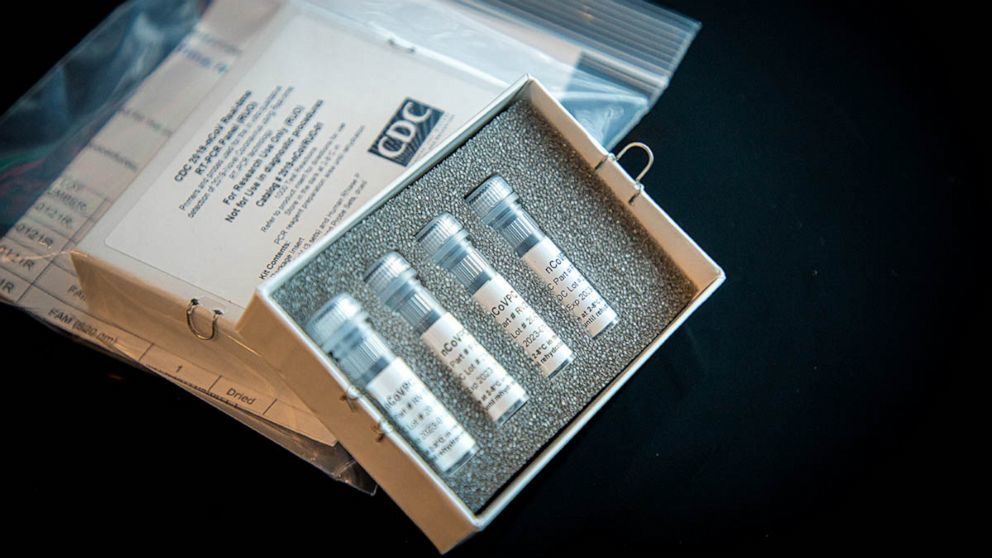Coronavirus: misleading case numbers now proven
Until now, the Robert Koch Institute and the German government have avoided collecting and publishing the number of corona tests carried out in Germany on a weekly basis. Instead, fear and panic were stirred up with case numbers taken out of context. Official data now prove for the first time that the rapid increase in case numbers is mainly due to an increase in the number of tests.
PAUL SCHREYER, 28 March 2020, 7 comments
The coronavirus continues to set the pace in the media and politics. Day after day, the public is alarmed by high numbers of new positively tested patients. While 300 new cases were added on 9 March, there were already 1,900 "newly infected" (more correctly: positively tested) on 16 March and even 3,200 on 23 March. The total number of cases in Germany rose in these two weeks from just over 1,000 to a frightening 32,000, and currently (March 28) there are about 50,000.
These figures indicate that the coronavirus is spreading rapidly across the country. In the middle of this threatening increase, the German government decided on 22.3. with the so-called "contact ban" to impose a massive and unprecedented restriction of civil liberties - for an indefinite period of time. The public remained in a state of rigor mortis - and to a large extent still does so.
As already mentioned in a previous article, the development of case numbers is only meaningful if they are continuously put in relation to the number of tests carried out. In other words: If in one week (or in one country) 10,000 tests are carried out and 1,000 infections are detected, but in the next week (or in another country) 20,000 tests and 2,000 infections are detected, this does not indicate a higher spread of the virus, but only a higher number of tests. In order to gain certainty about the continued spread of the virus, the number of tests carried out must therefore be continuously monitored.
On Monday, 23 March, Multipolar approached the Robert Koch Institute (RKI) and the Federal Ministry of Health (BMG) with corresponding inquiries. The BMG replied on Tuesday that there was no obligation to report tests, which is why the Ministry "does not have" the total number of all tests carried out in Germany.
The RKI initially reacted evasively, referring to the National Association of Statutory Health Insurance Physicians. When asked whether the RKI did not collect these data itself and how it could then seriously estimate the development of the spread of the virus and its dangerousness, the authority remained silent for several days. When we looked into the matter again on Thursday, a spokeswoman said
"There are estimates of the total number of tests... They range from 300,000 to 500,000 tests per week. The number of diseases per time unit allows a good estimate of the situation. The dark figure can be determined by antibody tests, such tests can be expected in the coming weeks."
As this information also did not provide any concrete information on the development of the number of tests, we asked again:
"In all probability, however, the number of tests has changed considerably in recent weeks. Therefore, the isolated consideration of the case numbers is hardly scientifically meaningful to measure the change in the risk to society. Once again the question with the request for a clear answer: "Why does the RKI not also collect and publish these figures so that everyone can get a clearer picture of the situation?
Again there was no answer at first, but after a further follow-up on the telephone, on Friday afternoon finally the surprising information that the RKI had published data in its situation report of Thursday (26.3.). Apparently, the RKI press office had not been aware of this at the time of the information on Thursday itself.
Number of tests tripled in one week
A glance at this report now shows for the first time that the increase in the number of cases has so far been presented in a highly misleading manner by the government and the media. On page 6 of the management report, there is a table showing the number of tests in calendar weeks 11 and 12 - this corresponds to the period from 9.3. to 22.3. From this, it can be seen that in week 11 almost 8,000 people in Germany tested positive, in week 12 almost three times as many, almost 24,000. These figures are already known from the media.
What has not been known until now: The number of tests carried out in Germany was almost 130,000 in week 11, but almost 350,000 in week 12. So not only the number of positively tested cases has approximately tripled, but also the number of tests. The actual increase in the number of cases, in relation to the number of tests, amounts to only one (!) percentage point: in week 11, just under 6% of those tested were found to be positive. In week 12 however, 7 %.
These data on the development of the test quantity were listed for the first time in the RKI situation report of 26 March - three days after the Multipolar request. However, in his press conference with Health Minister Jens Spahn on 26 March, the head of the authorities, Lothar Wieler, did NOT mention this new information. Even the Multipolar editorial staff would probably have overlooked it, as we do not constantly read the daily new 10-page RKI situation report, and the press office of the authority only pointed it out after several precise inquiries.
Incidentally, the information was removed in the following management report of 27.3. - so far, it has only been found in the management report of 26.3. It seems that the authority is not interested in a wider dissemination of this data.
Change in the test criteria
On March 25, the RKI also changed the criteria according to which doctors will decide who will be tested in the future. RKI head Wieler spoke of a "strategic measure". The decisive change: "The previous criterion that patients must have been in an area with COVID-19 cases will be dropped". A specialist journal reports on this:
"As before, only people who have respiratory [respiratory; P.S.] symptoms AND have had contact with a confirmed case of COVID-19, are nurses, doctors, hospitals or are at risk will be tested. Patients with acute respiratory symptoms, but WITHOUT the above-mentioned secondary conditions, should only be tested if sufficient test capacity is available.
It follows from the removal of one criterion that the number of tests - and thus the number of new cases to be expected - will continue to increase, while the retention of the remaining restrictions on access to the test (focus on risk groups) should ensure that the mortality rate will be relatively high in future. There are reasonable reasons for these criteria, but one should nevertheless bear in mind the expected impact on future figures, which will also have a psychological and thus political impact.
According to the latest data from the RKI (27.3.), the proportion of those who died in a positive test is 0.6%. Their average age (!) is 81 years according to RKI boss Wieler. From this, it is hardly possible to deduce an extreme risk for the entire population - especially since it is still completely unclear whether in the majority of these cases death is actually caused by the detected viral DNA material or by other previous diseases.
Problems with the PCR tests
Apart from the fact that the PCR tests used have not yet been officially tested and evaluated (validated), but have only been endorsed by cooperating institutes, PCR tests are generally subject to great uncertainty, as a recently published article explains:
"PCR is ultra-sensitive, which means that absurdly low DNA concentrations can be detected. On the other hand, the method is only moderately specific because PCR amplifies everything to which the primers [DNA building blocks used in the test; P.S.] can dock. This is the curse of the PCR method. On the one hand, the sample purity plays a role here. Is the DNA to be tested sufficiently purified, or are there residues of other DNA? (…)
In addition, a so-called gold standard, i.e. a method independent of PCR, is needed to prove that PCR amplifies the right thing. These are usually serological tests, but they are difficult with viruses because viruses are sometimes difficult to cultivate and isolate. For this reason, in recent years, also due to the lack of alternatives, PCR has become the gold standard. This is highly questionable. (…)
The situation becomes difficult if there are pathogenic (disease-causing) and harmless viruses in a sample, which may have similar gene sequences. Were the primers sufficiently specific or are there cross-reactions of the harmless viruses with the primers for the presumably dangerous viruses? Often only the assumption helps here. (…)
Whether or not something is found with PCR has nothing to do with the question of whether the species to which the DNA under investigation belongs is the cause of the disease. (...) There are a large number of viral pathogens that can cause mild or severe respiratory diseases, for example influenza viruses. In all cases, these would have to be detected with PCR or not in order to exclude them. However, if you only look for SARS-CoV-2 with PCR, you will only find or assign SARS-CoV-2. Whether SARS-CoV-2 is (exclusively) the cause of the respiratory disease cannot be said. [Emphasis P.S.] (...)
The mood in biomedicine is like this: Anything that seems dangerous to deadly is what drives research. And research is always good. Can you ever know enough? However, instead of creating knowledge, it often enough only reaches a reasonably consistent consensus. As long as the billions in research and profits flow, no one is bothered. (...) PCR diagnostics is a market worth billions. “
All in all, the available scientific data do not in any way justify the policy measures adopted. The potential for manipulation - and therefore the temptation to exploit it - is currently great. The ongoing fixation on pure case numbers, without classification in context, and in particular the decision to make these numbers the yardstick of politics, is manipulative and currently endangers the existence of civil rights in Germany and many other countries. The former Minister of Justice Sabine Leutheusser-Schnarrenberger warns:
"I consider it questionable that the Ministry of Health can deviate from all regulations of the infection protection law and other laws by legal decree. Laws should only be changed by parliament and not by the executive quasi as blanket authorization. (...) The separation of powers and the basic rights also apply in crisis situations."
The fact that the government is increasingly acting in an authoritarian manner and outside of control bodies is shown, for example, by the following report of 28 March:
"Chancellor's Office chief Braun ruled out possible loosening in the coming weeks. (...) 'We are not talking about any easing of the situation until 20 April', stressed the CDU politician (...). The yardstick for weaker precautionary measures is the speed with which infections are increasing. It must take 'ten, twelve or more days' until the number of cases doubles, then relaxation can be debated, Braun continued. Currently, it takes about three days for the number of cases to double.
The ball is now in the court of the Robert Koch Institute. One can imagine how great the political pressure on the scientists there is at the moment.




